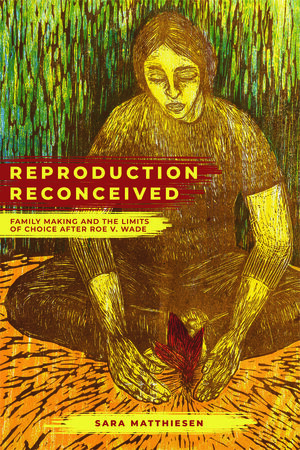The Book
Reproduction Reconceived: Family Making and the Limits of Choice after Roe V. Wade
The Author(s)
Sara Matthiesen

As recent state laws and federal court rulings threaten a dramatic constriction of reproductive freedom, Sara Matthiesen demonstrates the severe limitations that many women faced even after Roe v. Wade increased their control over childbearing. She refocuses our attention from deliberate restrictions on reproductive rights to official indifference to hardships faced by particular groups of women. Employing an expansive definition of reproduction, she explores the struggles of women on the margins of society to give birth and nurture families over four decades of state neglect that intensified the labor of motherhood.
The latest in a series on reproductive justice published by the University of California Press, Reproduction Reconceived shows how official neglect burdened attempts to bear and sustain children among five sets women: lesbians; incarcerated mothers; black women afflicted by high rates of infant mortality; poor women of color inordinately affected by the AIDs crisis; and women seeking the services of pro-life emergency pregnancy centers.
Throughout these explorations, Matthiesen reveals how various state and social institutions failed women in their attempts at family-making. For example, doctors denied lesbian’s efforts at in-vitro fertilization, while laws upheld paternity and made it difficult for lesbians to gain custody over their children. The advent of mass incarceration often severed mothers’ ties with their children and few prisons provided residential programs for mothers and children or regular visitation. The potential of reducing Black infant mortality rates by expanding Medicaid coverage for prenatal care was limited by cuts in welfare. Public officials and the medical establishment neglected the AIDS epidemic among women of color, and for two decades women of childbearing age were denied participation in trials of new drugs amidst concerns about risk.
Matthiesen enlivens her arguments with examples of individual women struggling to bear and sustain children, and she provides new information about national and local grass roots movements organized to alleviate those struggles. The Oakland (California) Feminist Women’s Health Center, for example, began providing artificial insemination to single women in 1982, and lawyers for the Lesbian Rights Project fought for lesbians’ rights to custody. Legal Services for Prisoners with Children filed lawsuits on behalf of incarcerated women in California and won some small successes in affording and strengthening mother-child connections. In California the Third World Women’s Alliance worked to re-direct blame for high rates of infant mortality from mothers to inadequate health care provision; and in Philadelphia, the Maternity Care Coalition provided both services and advocacy for poor mothers. Atlanta’s Women with AIDS Partnership project provided information to women disproportionately affected by the crisis, while the HIV Law Project pushed for women to be included in drug trials. Although such efforts made small headways, as a whole, they failed to overcome the circumstances that made reproduction so difficult for many women.
The final chapter of the book takes a different approach. Focusing on pro-life emergency pregnancy centers, Matthiesen underscores the state neglect that drove women to turn to them and sheds new light on these operations. Although founded to divert women away from legal abortion, these centers provided often-overlooked essential support—such as material goods and access to social services–that poor women could not find elsewhere. Unlike the groups described in earlier chapters, emergency pregnancy centers were not interested in changing institutions that placed impossible demands on motherhood, but they did provide material support to ease the burdens of women who wanted to carry their babies to term, the vast majority of their clients. Along with this support came anti-abortion propaganda, an emphasis on traditional family values, and requirements that clients participate in religious activities.
Reproduction Reconceived is based on extensive research in dozens of manuscript collections, official records, research studies, legislative records, and organizational publications. Its arguments and conclusions shed new light on the harsh conditions that encumber so many women’s efforts at family-making, call for a change in values that fully appreciate and support the essential work of private and public caregiving, and insist that making reproductive choice a reality demands the elimination of inequities based on gender, race, class and sexuality.
About the Reviewer
Susan M. Hartmann is Arts and Humanities Distinguished Professor of History Emerita at Ohio State University and the author of several books on feminism, gender, and politics.

0